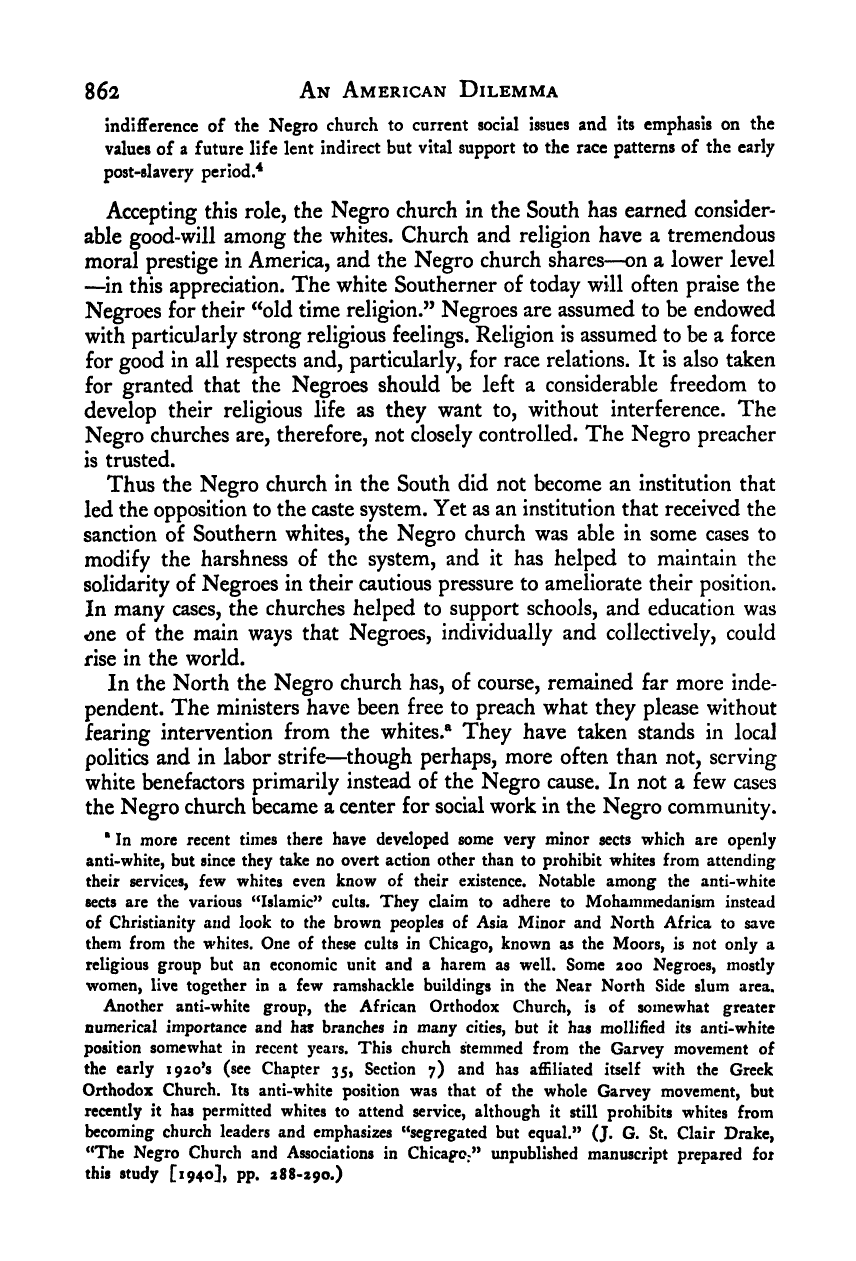Note: Gunnar Myrdal died in 1987, less than 70 years ago. Therefore, this work is protected by copyright, restricting your legal rights to reproduce it. However, you are welcome to view it on screen, as you do now. Read more about copyright.
Full resolution (TIFF) - On this page / på denna sida - IX. Leadership and Concerted Action - 40. The Negro Church - 2. Some Historical Notes

<< prev. page << föreg. sida << >> nästa sida >> next page >>
Below is the raw OCR text
from the above scanned image.
Do you see an error? Proofread the page now!
Här nedan syns maskintolkade texten från faksimilbilden ovan.
Ser du något fel? Korrekturläs sidan nu!
This page has never been proofread. / Denna sida har aldrig korrekturlästs.
862 An American Dilemma
indifFerence of the Negro church to current social issues and its emphasis on the
values of a future life lent indirect but vital support to the race patterns of the early
post-slavery period.^
Accepting this role, the Negro church in the South has earned consider-
able good-will among the whites. Church and religion have a tremendous
moral prestige in America, and the Negro church shares—on a lower level
—^in this appreciation. The white Southerner of today will often praise the
Negroes for their ^^old time religion.” Negroes are assumed to be endowed
with particularly strong religious feelings. Religion is assumed to be a force
for good in all respects and, particularly, for race relations. It is also taken
for granted that the Negroes should be left a considerable freedom to
develop their religious life as they want to, without interference. The
Negro churches are, therefore, not closely controlled. The Negro preacher
is trusted.
Thus the Negro church in the South did not become an institution that
led the opposition to the caste system. Yet as an institution that received the
sanction of Southern whites, the Negro church was able in some cases to
modify the harshness of the system, and it has helped to maintain the
solidarity of Negroes in their cautious pressure to ameliorate their position.
In many cases, the churches helped to support schools, and education was
one of the main ways that Negroes, individually and collectively, could
rise in the world.
In the North the Negro church has, of course, remained far more inde-
pendent. The ministers have been free to preach what they please without
fearing intervention from the whites.® They have taken stands in local
politics and in labor strife—though perhaps, more often than not, serving
white benefactors primarily instead of the Negro cause. In not a few cases
the Negro church became a center for social work in the Negro community.
* In more recent times there have developed some very minor sects which are openly
anti-white, but since they take no overt action other than to prohibit whites from attending
their services, few whites even know of their existence. Notable among the anti-white
sects are the various ^^Islamic” cults. They claim to adhere to Mohammedanism instead
of Christianity and look to the brown peoples of Asia Minor and North Africa to save
them from the whites. One of these cults in Chicago, known as the Moors, is not only a
religious group but an economic unit and a harem as well. Some 200 Negroes, mostly
women, live together in a few ramshackle buildings in the Near North Side slum area.
Another anti-white group, the African Orthodox Church, is of somewhat greater
numerical importance and haf branches in many cities, but it has mollified its anti-white
position somewhat in recent years. This church stemmed from the Garvey movement of
the early i92o*s (see Chapter 35, Section 7) and has affiliated itself with the Greek
Orthodox Church. Its anti-white position was that of the whole Garvey movement, but
recently it has permitted whites to attend service, although it still prohibits whites from
becoming church leaders and emphasizes “segregated but equal.” (J. G. St. Clair Drake,
“The Negro Church and Associations in Chicago*” unpublished manuscript prepared for
this study [1940], pp. 288-290.)
<< prev. page << föreg. sida << >> nästa sida >> next page >>